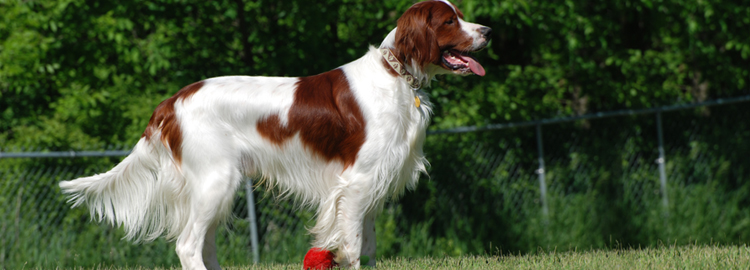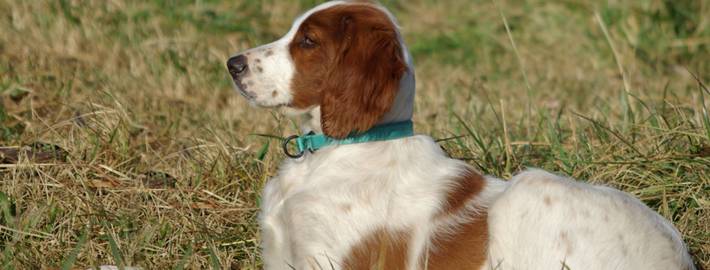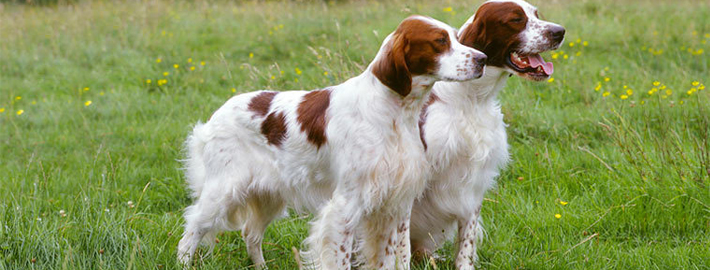What makes the Irish Red and White Setter Unique?
The Irish Red & White Setter is bred primarily for the field. The standard as set out hereunder must be interpreted chiefly from this point of view and all Judges at Bench Shows must be encouraged to judge the exhibits chiefly from the working standpoint. The appearance is strong and powerful, well balanced and proportioned without lumber; athletic rather than racy with an aristocratic, keen and intelligent attitude.
Page Contents
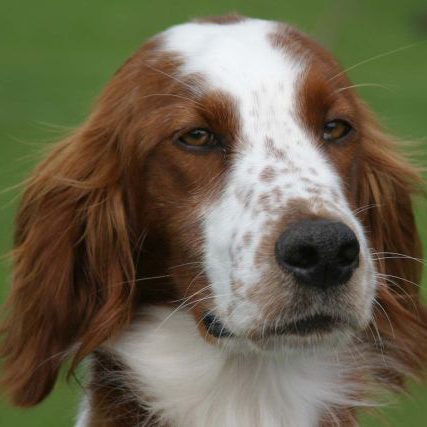
Is the Irish Red and White Setter Right For You?
The good-natured and affectionate Red and White is not only a popular hunting dog. Thanks to his excellent scenting ability and strong natural instincts for pointing and retrieving, he does double-duty as a family friend. He likes kids and can fit well into a family with children, with the caveat that he is pretty rambunctious, especially as a pupster, and should always be supervised around toddlers.
In 5 Words
- Loving
- Energetic
- Affectionate
- High-spirited
- Intelligent
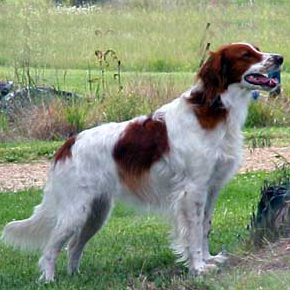
Characteristics
Learn About the Irish Red and White Setter
Description
General Description
The Irish Red and White Setter is strong and powerful, without lumber—athletic rather than racy. The head is broad in proportion to body, with a good stop. Skull is domed without occipital protuberance as in Irish Red Setters; fairly square, clean muzzle. The eyes are hazel or dark brown, round, slight prominence and without haw. The ears are set level with the eyes and well back, lying close to head. The jaw is strong with a perfect regular scissor bite, i.e. upper teeth closely overlapping lower teeth and set square to the jaws. The neck is moderately long, very muscular, but not too thick, slightly arched and free from throatiness. The shoulders are well laid back. Elbows free, turning neither in nor out. Strong, oval bone well-muscled, sinewy, pasterns slightly sloping. The body is strong and muscular, deep chest and well sprung ribs. Back and quarters very muscular and powerful. Bone strong, well built up with muscle and sinew. The hindquarters are wide and powerful. Legs from hip to hock long and muscular; from hock to heel short and strong. Stifle well bent, hocks well let down turning neither in nor out. The feet are close-knit, well feathered between toes. The tail is strong at the root, tapering to fine point, with no appearance of ropiness, not reaching below hock. Well feathered, carried level with back or below in lively manner. The coat is finely textured with good feathering. Slight wave permissible but never curly. Coat colors are clearly parti-colored, i.e. base color white, solid red patches. Mottling or flecking but not roaning permitted around face and feet and up foreleg to elbow and up the hind leg to the hock.
Short History of the Irish Red and White Setter
Most people are much more familiar with the Red Setter breed. However, it is believed that the Red and White Setter, which dates back to the 17th century, is actually the older of the two breeds. Near the end of the 19th century, the Red and White Setter, like many other breeds of the time, suffered in number due to the hardships of WWI in Ireland. Its numbers became so rare, in fact, that the breed was thought to be extinct.
Fortunately, efforts to revive the Irish Red and White Setter in the 1920s proved successful. In the 1980s the Irish Kennel Club recognized the breed as one separate from the Irish Setter. The American Kennel Club would not formally recognize the Irish Red and White Setter until 2009.
Today the Irish Red and White Setter can be found in healthy amounts both in the U.S. and abroad, especially competing against other pointing breeds at Irish Shows and Field Trails as gun dogs.
Temperament
They display a kindly, friendly attitude, behind which is discernible determination, courage and high spirit.
Irish Red and White Setters are energetic, intelligent, affectionate, loving, high-spirited and full of energy. They have no guarding instincts, get along with other pets and are good with children. This breed can be reckless and high-strung if it do not receive the proper amount of mental and physical exercise and may become destructive and hard to manage. Impulsive, with an independent spirit, they are sensitive to the tone of one’s voice and will not listen if they sense that they are stronger minded than their owner, however they will also not respond well to harsh discipline.
Caring for Your Irish Red and White Setter
Grooming & Bathing
The trimming of an Irish Red and White Setter should be kept to a minimum, maintaining a neat natural appearance and not to be shaved with clippers. Light trimming with thinning shears is allowed. Under the ears, tail, pasterns and hocks may be trimmed for neatness. Feet may be cleared of hair including the bottom and around the edges leaving hair between the toes. No other trimming is allowed including the whiskers which shall remain intact.
Exercise & Training
All setters need a daily long, brisk walk or jog or they will become restless and difficult to manage. Do not allow the dog to walk in front of the person holding the lead. The dog must be made to heel beside or behind the human, as in the dog’s mind, the leader goes first and that leader must be the human. In addition, they will also enjoy running free in the safety of a fenced yard.

